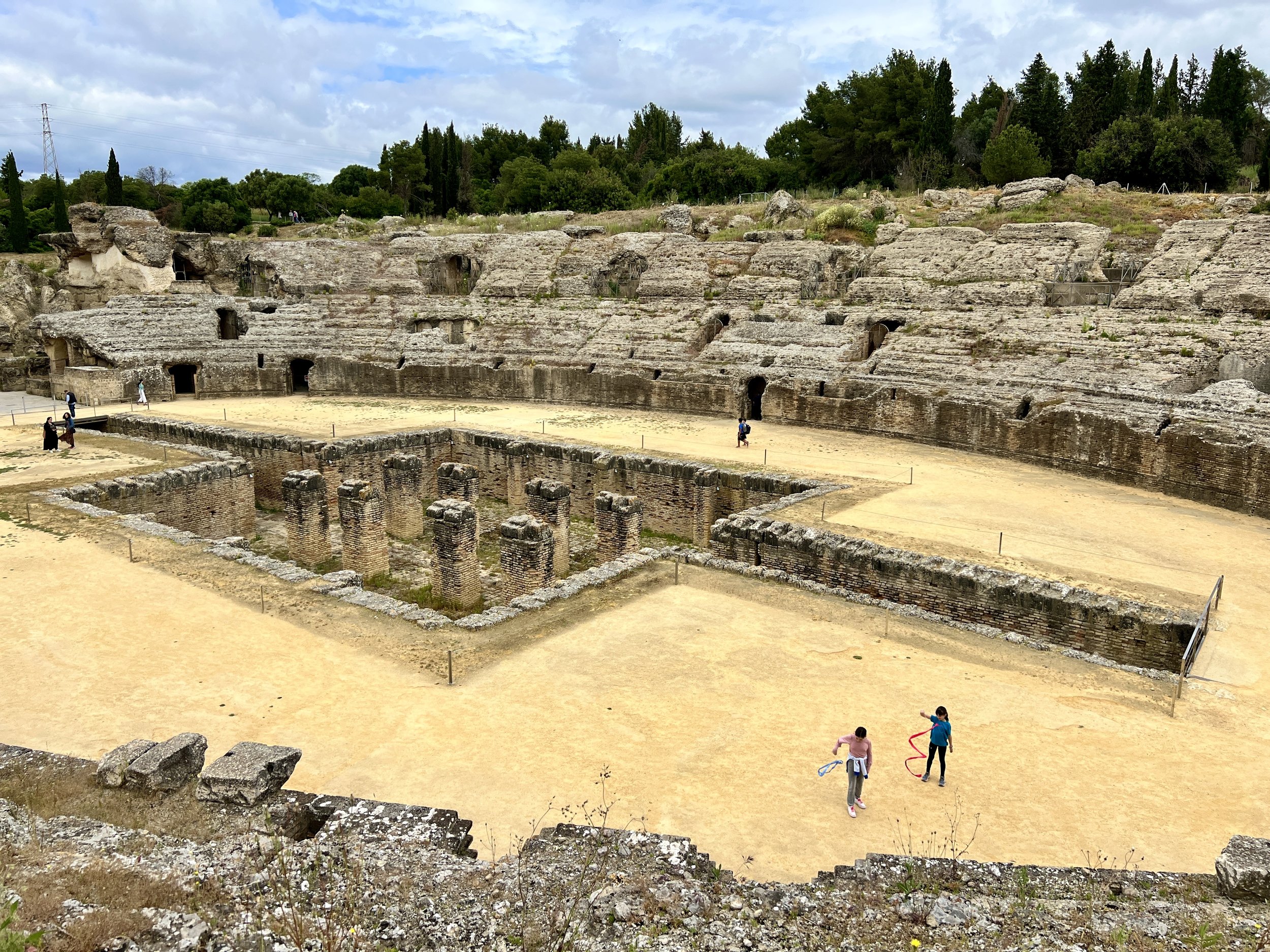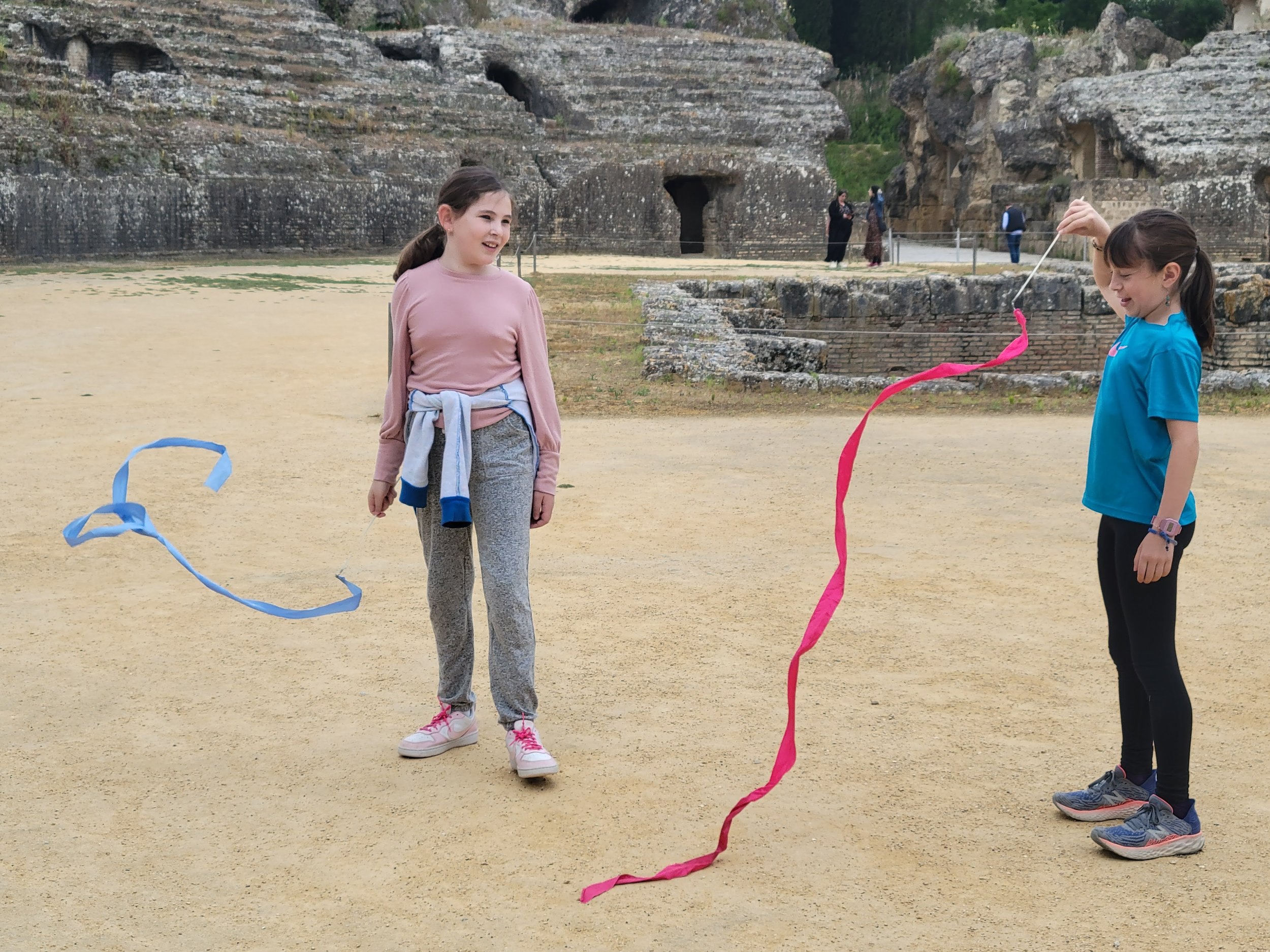Worldschool Hubbing in Seville
When planning our adventures in Spain, we knew a few of the experiences we definitely wanted to include. We wanted to revisit Barcelona, experience the Alhambra in Granada (though Masha had been there before), and find out if Valencia was as welcoming to the nomad lifestyle as we had heard. But the experience we booked first was a week-long worldschooling hub in Seville. After trying a hub in Japan, Alya and Masha were excited to do it again, and so we planned to go to one for Alya’s birthday. That way, we’d have company for our celebrations!
Because we had a free travel week before the start of the hub, we decided to spend that in Seville as well, choosing to really soak in this beautiful place. Thus, by the time the hub’s socially intense daily schedule started, we had already started getting a feel for the city. And a good thing that was. Socializing all day almost every day was great on one hand, but on the other, it was a bit much for our introvert selves.
What’s a worldschooling hub?
Like most worldschooling hubs, this one was composed of families with school-aged kids. Indeed, across the more than dozen families that attended, the children ranged from kindergarten (with a few younger siblings) to a 17 year old. Yet much of the time, they all played together remarkably well!
Because Alya’s birthday fell right in the middle of hub schedule, we actually had quite a group to celebrate. We took turns being apprehensive about how it would work out — should we just invite the couple kids Alya really gelled with, do we invite everybody? What would we do with a large and varied group? Where could we go? Luckily, we discovered an arcade and a delicious Japanese restaurant a few blocks away from us — problem solved!
Group-Touring Seville
This wasn’t just hanging out for days on end (though there was a lot of hanging out)! The hub hosts — Mark and Suzy, who were actually living in Sevilla —- planned several activities per day to acquaint us with their city’s primary attractions.
Of course, one of them was a return to the Plaza de España (we had already visited it on a tour — this time to witness a flash downpour and a visit by Sevilla’s hissing political leadership (😮)
We also toured several minor sites, like
The Basilica de la Macarena (built in the 20th century!?) and the two thousand year old Roman wall next to it. That’s Europe for you…
The Waffle — at least that’s what I called this odd new construction in the middle of the city. Officially it is known as Setas De Seville. Does it look like mushrooms to you?
We are going to be on top of this waffle shortly…
A recent addition to the city, as far as I can tell, the Waffle is famous because it’s famous, a la Kardashians. It does, however, have the virtue of offering a nice view of the city, being pretty much the tallest accessible points in the middle of this remarkably low level place
It also sports a short video on the history of Seville on a wrap-around screen
The kids chilling after walking all day
Mark and Suzy also guided us to a few historic sites we didn’t imagine being there. It turns out the Romans were fans of the area, and under Scipio they established a sizable city just a few miles outside modern Seville. Italica was considered one of the major cities of the Roman Empire (birthplace to several of its emperors, including Hadrian) and today boasts a superbly preserved colosseum — an excellent place to twirl streamers —



— as well as numerous elaborate and still colorful mosaics. Eat your heart out Pompeii!
This was actually an excellent example of Alya learning through travel. Although, having become obsessed with Greek myths, she already knew the story of Bacchus and Ariadne (above), Italica demonstrated how modern language (well, Spanish in this case) is rooted in history —
— and how much today’s modern social norms differ from the past
Hello old Roman public bathroom with no walls
We even got the unexpected bonus of running into a couple of Romans still mucking around the place who were all too happy to pose with us
Finally, Sevilla’s biggest attraction is its Royal Alcazar. Seeing it only two weeks after touring Alhambra in Granada, a comparison is irresistible. While somewhat smaller than the Alhambra complex, the Alcazar fared better. Perhaps it is because the Alcazar has maintained more royal favor over the years (the royal family still stays in the Alcázar when visiting Seville). The color and grandeur of the interior decoration of the Alcazar are much better preserved and recall the dazzling decor of Timur’s tomb in Samarkand
Alcazar also sports stunning pool-bisected courtyards common to Arabic palaces
As Sevilla served as the capital of several Arabic dynasties before being conquered by the Castilian kingdom in the 14th century, the palace is a rich tapestry of architectural styles spanning a full millennium. Indeed, it’s pretty easy to guess the century of any particular building. As you hit Castillano, you start with the room where Isabella received Columbus on his return from America. Spain is very proud of Ferdinand and Isabella, who not only sponsored Columbus, but also united the Spanish kingdoms. Any possible link to them in a given city will be touted to the max.
Can you imagine Columbus here?
Then there are the halls lined with the region’s traditional tilework (in the style of 16th and 17th century)
And the conquest room of 17th and 18th centuries, with each enormous rug depicting a triumphant scene
And just when you think you are done, there are still the gardens to tour, including a massive — and tricky — hedge maze!
Escaping from the maze by the skin of your teeth, you breathe a sigh of relief. But then, “did you see underground caverns?” you overhear. Yup, just when you thought you were done — there are also chambers under much of the castle. They served as storage we believe, keeping the goods cool…
It was a long (half) day. And it was a new experience for us -- touring a large attraction with a group. With kids of different ages, and of various energy levels, running in all directions, it was at times quite hectic. For much of the time, we split in smaller groups, with different people mixing in and out. But having company on Alya’s birthday (what are the odds this would be the castle day!) made it pretty cool
Interestingly, we didn’t have the same hectic feeling while touring Italica, which was more enjoyable as part of the group. Perhaps the difference can be chalked up to the exorbitant amount of stuff “to see” in Alcazar demanding a faster pace, and constant navigation of different rooms and buildings. In comparison, the more relaxed and open Italica begged for company.
Group activities
The hub wasn’t just historical sightseeing and hanging out in parks, however. Though, we did hang out in lots of parks. Our hosts also planned a number of activities for the group. There was tile painting, flamenco, churro tasting, an amusement park, an escape room, and a maritime museum as well. While I took some time to introvert, Masha and Alya embraced all the arts, crafts and escaping with style!
I don’t know that we said it enough at the time, but Mark and Suzy, if you read this, thank you for making this happen!
The Hub Experience - In Retrospect
Hanging out continuously with a group of strangers (well initially!) for a whole week was a sharp of contrasts to our Bay Area life, where we spent bits of time with well familiar friends. And, perhaps, if all the families were there for all the activities each and every day, it would have been overwhelming. But the loose structure of the week — letting anyone filter in and out of activities as they wished made it a lot easier. While a core group of 4-5 families of committed extraverts joined in for all the activities, most — including us — carved out occasional family time and skipped some of the activities that catered to other age groups.
The hub was also unique in the unusual range of people that came together that week, a fascinating cross slice of the worldschooling movement. The families ranged from libertarians to vegans, from permanent nomads to families coming out for just a week over spring break, and also included American families traveling for a gap year or two -- like us.
There were people from Europe, Asia, USA, Latin America and the Middle East. And we all had one thing in common - we loved to travel, to learn and to open ourselves up to others, respecting their otherness and also finding all of our common ground. It was a week to remember, and an experience we would definitely repeat.




























































